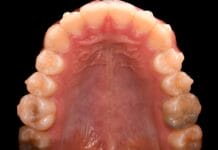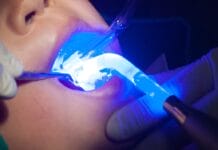Dental caries is a multifactorial disease and affects a large portion of the population. It is one of the most prevalent health conditions in children. A 2020 meta-analysis found that the worldwide prevalence of dental caries in primary teeth was 46.2%, and 53.8% of permanent teeth worldwide had caries. Childhood caries rates in developing countries are higher than in developed countries, potentially due to personal and oral environmental factors.1
Dental caries develops when the oral microbiome metabolizes dietary fermentable sugars, causing an acidic environment. If the pH drops below 5.5, the enamel begins to demineralize. Left untreated, caries can progress and affect the pulp, leading to pain, infection, inflammation, tooth loss, necrosis, and, in severe cases, systemic sepsis.1
Saliva plays a protective role in the prevention of dental caries by facilitating the dilution and elimination of fermentable carbohydrates and sugars. In addition, once sugars are cleared from the mouth by salivary dilution and swallowing, saliva’s neutralizing or buffering capacity helps restore the pH to a neutral level. Furthermore, if saliva is sufficiently saturated with calcium and phosphate ions, demineralization can be halted, which promotes mineral redeposition (remineralization).1
The initial understanding of vitamin D indicated it was exclusively related to bone metabolism. However, it is now recognized that most cells in the body, including odontoblasts, ameloblasts, and salivary glands, have vitamin D receptors. Vitamin D binding to these receptors modulates the expression of numerous genes related to mineral metabolism, cell life cycle, immune response, and energy metabolism.1
In 1928, a study completed by Mellanby and Pattison was published, providing the first evidence that vitamin D deficiency is associated with dental caries in children. This study also verified that dietary supplementation with vitamin D decreased the risk of caries.1
Since then, multiple epidemiological studies, systematic reviews, and meta-analyses have investigated the association between vitamin D deficiency and dental caries in primary and permanent teeth in children. These studies suggest that vitamin D exposure in early life may play a role in caries prevention, possibly by vitamin D’s influence on tooth mineralization through changes in calcium and phosphate ion concentrations, similar to its known effects on bone.1
Further evidence suggests that early-life vitamin D exposure may contribute to caries prevention, with findings ranging from significantly lower caries incidence in supplemented young children to higher caries levels in infants born to mothers with vitamin D deficiency, as well as an inverse relationship with prenatal vitamin D levels.1
A literature review aimed to identify proposed mechanisms that would “explain the role of vitamin D as a protective factor against dental caries in children.”1
The Review
A literature search was completed using PubMed. Articles published between January 1985 and May 2023 were considered for the review. Though published outside the date range, the study by Mellanby and Pattison (1928) was included due to its historical relevance.1
The Results
The results indicated multiple potential mechanisms that may explain the role of vitamin D in preventing caries in children, including developmental defects, antimicrobial effects, and salivary dysfunction.1
Developmental Defects
Primary teeth form as early as 6 weeks into embryonic life, with enamel and dentin development continuing into the second trimester and after birth. Vitamin D plays a vital role in odontogenesis (tooth development), influencing the formation and mineralization of enamel and dentin by regulating genes involved in producing key dental proteins.1
Evidence suggests that a deficiency in vitamin D during pregnancy can lead to developmental defects in primary teeth, such as enamel hypoplasia and dentin hypomineralization, which have been associated with a higher risk of dental caries in children.1
Additional evidence from a clinical trial showed that high-dose vitamin D supplementation during pregnancy (2400 IU/day) was associated with a reduced prevalence of enamel defects compared to the standard dose (400 IU/day). This suggests that maintaining adequate vitamin D levels before and during pregnancy may help prevent enamel defects and lower childhood caries risk.1
In summary, these findings suggest that since vitamin D plays a role in tooth development, a vitamin D deficiency during pregnancy may lead to enamel defects, contributing to a higher caries risk. Therefore, controlling vitamin D levels before conception and throughout pregnancy may help mitigate the risk of childhood caries.1
Antimicrobial Effects
Vitamin D plays an essential role in regulating innate and adaptive immune responses. It influences immune cells such as B and T lymphocytes, monocytes, dendritic cells, and neutrophils by binding to the vitamin D receptor, helping to control inflammatory responses and enhancing immune defense functions.1
In the innate immune system, vitamin D promotes the production of antimicrobial proteins (AMPs) like cathelicidin. Cathelicidin disrupts bacterial membranes and plays a role in immune signaling and cell defense, particularly against oral pathogens such as Streptococcus mutans, a significant contributor to dental caries.1
Studies have found that children with vitamin D deficiency have lower levels of cathelicidin in saliva and are more likely to have dental caries, whereas caries-free children have higher levels. These findings suggest that maintaining optimal vitamin D levels may enhance oral innate immunity and reduce the risk of dental caries, and that AMPs may hold promise as a future preventive or therapeutic tool in caries management.1
Salivary Dysfunction
Studies have reported a strong, positive correlation between serum and salivary vitamin D levels in children and adults, suggesting that saliva testing may be a non-invasive alternative to blood testing for vitamin D status. Salivary glands contain vitamin D receptors, making them direct targets for vitamin D’s effects.1
Vitamin D is essential for salivary gland function, influencing the secretion and composition of saliva. Deficiency can reduce salivary flow and calcium content, weakening its buffering capacity and compromising protection against dental caries. Saliva also delivers minerals vital for tooth remineralization. Vitamin D deficiency can impair this process and increase caries risk.1
Supplementation recommendations for pregnant women are 1500–2000 IU/day of cholecalciferol (vitamin D), starting as early as possible. The recommended dietary allowance and adequate vitamin D intake in Infants (0–1 year) is 400 IU/day from birth, and for children (1-18 years) is 600 IU/day. Those at risk for deficiency may need higher doses to maintain optimal levels and support systemic and oral health.1
The patient’s primary care physician, pediatrician, or OB/GYN should manage vitamin D supplementation, highlighting the importance of collaborative care.
Conclusion
Dental caries is a complex, biofilm-mediated disease primarily driven by behaviors such as frequent consumption of fermentable carbohydrates, poor oral hygiene, and inadequate fluoride exposure.1
Evidence suggests that vitamin D deficiency during pregnancy and childhood increases caries risk. Mechanisms identified in this review include enamel hypoplasia in utero, reduced antimicrobial peptide activity, and lower salivary flow and calcium levels in saliva, reducing buffering capacity.1
Considering this evidence, the authors conclude that vitamin D deficiency should be considered a modifiable risk factor for dental caries in children. Maintaining optimal vitamin D levels during pregnancy and throughout childhood may serve as a preventive strategy for both primary and permanent teeth. Public education on the role of vitamin D in oral health is strongly recommended.1
Before you leave, check out the Today’s RDH self-study CE courses. All courses are peer-reviewed and non-sponsored to focus solely on high-quality education. Click here now.
Listen to the Today’s RDH Dental Hygiene Podcast Below:
Reference
1. Durá-Travé, T., Gallinas-Victoriano, F. Dental Caries in Children and Vitamin D Deficiency: A Narrative Review. Eur J Pediatr. 2024; 183(2): 523-528. https://pmc.ncbi.nlm.nih.gov/articles/PMC10912272/










